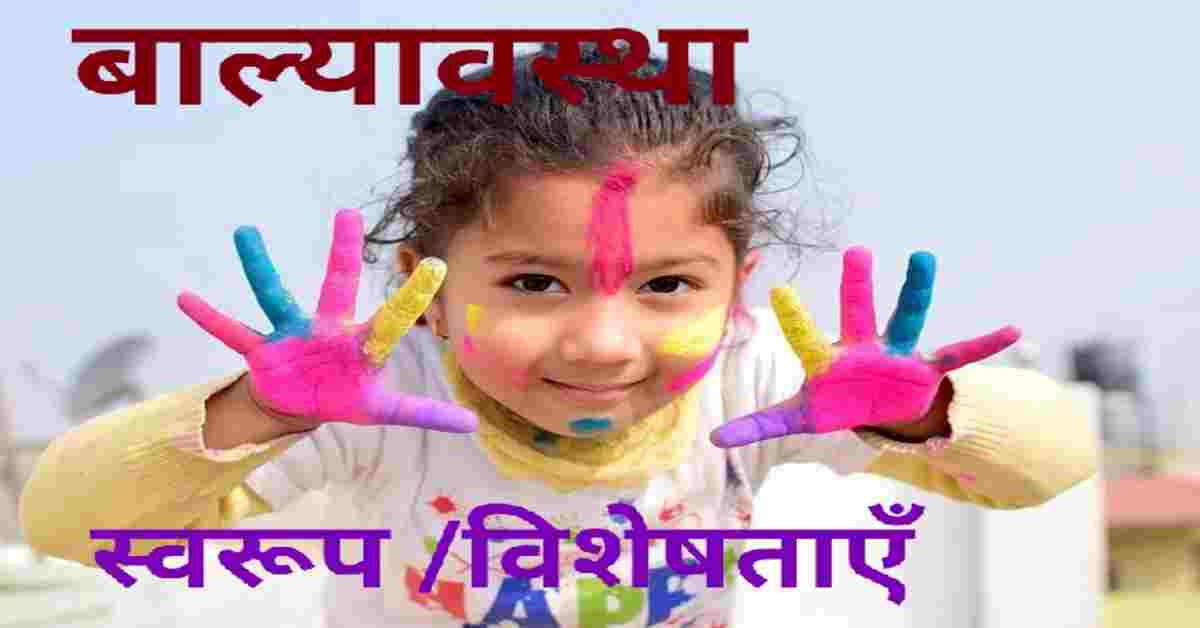
Childhood - Child Development and Pedagogy | बाल्यावस्था- बाल विकास एवं शिक्षाशास्त्र
शैशवावस्था- के पश्चात बाल्यावस्था का प्रारंभ होता है। बाल्यावस्था, वास्तव में मानव जीवन का वह स्वर्णिम समय है जिसमें उसका सर्वागीण विकास होता है। यह अवस्था 5 वर्ष से 12 वर्ष तक की अवधि मानी जाती है। इस अवस्था में बालक में अनेक अनोखे परिवर्तन होते हैं। इसलिए विकास की दृष्टि से इस अवस्था को एक जटिल अवस्था माना जाता है। मनोवैज्ञानिकों ने इस अवस्था को जीवन का अनोखा काल कहते हैं। इस अवस्था में सामाजिकता का अधिकतम विकास हो जाता है। बालक में नैतिकता विकसित हो जाती है जिससे वह उचित-अनुचित का निर्णय बहुत से मामलों में कर पाता है। इस अवस्था में बालक आत्मनिर्भर होने के साथ-साथ परिपक्व भी होने लगता है। इस अवस्था में मित्र बनाने की प्रबल इच्छा होती है। बालक जीवन की वास्तविकता को परखते हुए उसकी समझ विकसित करने लगता है। इस अवस्था की एक सबसे बड़ी विशेषता उसकी संग्रह प्रवृत्ति है। वह अर्थपूर्ण व अर्थहीन दोनों तरह की वस्तुओं का संग्रह करने लगता है। बाल्यावस्था में अपने समूह के प्रति बड़ी आस्था होती है। उसमें आपस में सहयोग, प्रेंम, सहानुभूति का भाव विकसित होता है। अनेक प्रकार की रूचियाँ इस अवस्था में जागृत होने लगती है। इस अवस्था में बालक में जिज्ञासु प्रवृत्ति बढ़ जाती है वह अनेक प्रकार के प्रश्न पूछने लगता है। इस अवस्था में बालक के अंदर विभिन्न आदतों व्यवहार, रूचि एवं इच्छाओं के प्रतिरूपों का निर्माण होता है। 6 वर्ष की आयु में बालक का स्वभाव बहुत उग्र होता है। 7 वर्ष की आयु में वह उदासीन हो जाता है एवं अकेले रहना पसंद करता है। 8 वें वर्ष में उसमें अन्य बालकों में सामाजिक संबंध स्थापित करने की भावना प्रबल होती है। 0 से 12 वर्ष तक की आयु में विद्यालय का उसके लिए कोई विशेष आकर्षण नहीं रहता। वह कोई नियमित कार्य करने, कोई महान और रोमांचकारी कार्य करना चाहता है।
Childhood begins after infancy. Childhood is, in fact, the golden time of human life in which all round development takes place. This stage is considered a period from 5 years to 12 years. There are many unique changes in the child in this state. Therefore this stage is considered to be a complex state in terms of development. Psychologists call this stage the unique period of life. At this stage, maximum development of sociality takes place. Morality develops in the child, so that he is able to decide the right and the unfair in many cases. In this state, the child becomes self-sufficient as well as matures. In this stage there is a strong desire to make friends. The child begins to develop his understanding by examining the reality of life. One of the biggest features of this stage is his collection trend. He starts collecting both meaningful and meaningless items. In childhood, there is great faith in one's group. In it, a sense of cooperation, love, sympathy develops. Many types of interests begin to awaken in this state. In this state, the child has an inquisitive tendency, he starts asking many types of questions. In this state, patterns of behavior, interests and desires are created inside the child. At the age of 6, the child's temperament is very fierce. At the age of 7, he becomes apathetic and likes to be alone. In the 8th year, the spirit of establishing social relations in other children prevails in it. The school has no special attraction for him from 0 to 12 years of age. He wants to do some regular work, some great and thrilling work.
बाल्यावस्था को मुख्यतः दो चरणों में बाँटा जा सकता है-
प्रथम चरण- 6 से 9 वर्ष एवं
द्वितीय चरण- 9 से 12 वर्ष।
प्रथम चरण में बालक की लंबाई एवं भार दोनों पढ़ते हैं। इस काल में बच्चे में चिंतन एवं तर्क शक्तियों का विकास हो जाता है।
Childhood can be divided into two main stages-
First Phase - 6 to 9 years and
Second Stage - 9 to 12 years.
In the first phase, both the length and weight of the child are read. During this period, the child develops thinking and reasoning powers.
द्वितीय चरण में बच्चे पढ़ाई में रुचि लेने लगते हैं। फ्रायड यद्यपि यह मानते हैं कि बालक का विकास 5 वर्ष की आयु तक हो जाता है, लेकिन बाल्यावस्था विकास की प्रक्रिया को गति प्रदान करती है और एक परिपक्व व्यक्ति के निर्माण की ओर अग्रसर होती है।
In Phase II, children start taking interest in studies. Freud Although it is believed that the child develops by the age of 5, childhood accelerates the process of development and leads to the creation of a mature person.
इन 👇 प्रकरणों के बारे में भी जानें।
1. बाल विकास क्या है इसकी अवधारणा एवं परिभाषाएंँ
2. बाल विकास की विशेषताएंँ
3. विकास के अध्ययन की उपयोगिता- बाल विकास एवं शिक्षाशास्त्र
4. बाल विकास के अध्ययन में ध्यान रखे जाने वाली प्रमुख बातें
5. गर्भावस्था एवं माता की देखभाल
6. शैशवावस्था- स्वरूप, महत्वव विशेषताएँ
बाल्यावस्था की विशेषताएँ (Characteristics of childhood)-
(1) विकास में स्थिरता (Growth stability)- बालक में 6 से 7 वर्ष की अवस्था के बाद शारीरिक और मानसिक विकास में स्थिरता आ जाती है। यह स्थिरता उसकी शारीरिक मानसिक शक्तियों को दृढ़ता प्रदान करती है। फलस्वरूप उसका मस्तिष्क परिपक्व और वयस्क सा जान पड़ता है। इसलिए रॉस महोदय ने इसे “मिथ्या परिपक्वता” का काल बताते हुए कहा है कि “शारीरिक और मानसिक स्थिरता बाल्यावस्था की सबसे महत्वपूर्ण विशेषता है।”
After 6 to 7 years of age in the child, there is stability in physical and mental development. This stability lends strength to his physical mental powers. As a result, his brain looks like a mature and adult. That's why Ross calls it a period of "false maturity", saying that "physical and mental stability is the most important feature of childhood."
(2) मानसिक योग्यताओं में वृद्धि (Increase in mental abilities)- बाल्यावस्था में बालक की मानसिक योग्यताओं में निरंतर वृद्धि होती है। उसकी संवेदना और प्रत्यक्षीकरण की शक्तियों में वृद्धि होती है। वह विभिन्न बातों के बारे में तर्क व विचार करने लगता है। वह साधारण बातों पर अधिक देर तक अपने ध्यान को केंद्रित कर सकता है। उसमें अपने अनुभवों को स्मरण करने की योग्यता उत्पन्न हो जाती है।
There is a continuous increase in the mental abilities of the child in childhood. His powers of sensation and articulation increase. He starts to reason and think about various things. He can focus his attention on simple things for a long time. It creates the ability to remember their experiences.
(3) जिज्ञासा की प्रबलता (Intensity of curiosity)- बालक में जिज्ञासा विशेष रूप से प्रबल होती है। वह जिन वस्तुओं के संपर्क में आता है, उनके बारे में प्रश्न पूछ कर हर तरह की जानकारी प्राप्त करना चाहता है। उसके ये प्रश्न शैशवावस्था से भिन्न होते हैं। बालक ‘यह क्या है?’ जैसे प्रश्न के स्थान पर ‘इसमें ऐसा क्यों है?’ जैसे प्रश्न पूछता है।
Curiosity is particularly strong in the child. He wants to get all kinds of information by asking questions about the objects he comes in contact with. His questions are different from childhood. The child asks questions like 'Why is this?' Instead of 'Why is this?'
(4) वास्तविक ज्ञान का विकास (Development of real knowledge)- इस अवस्था में बालक, शैशवावस्था के काल्पनिक जगत का परित्याग करके वास्तविक जगत में प्रवेश करता है। उसकी प्रत्येक वस्तु से आकर्षित होकर उसका ज्ञान प्राप्त करना चाहता है।
At this stage, a child abandons the imaginary world of infancy and enters the real world. Attracts from each of his objects and seeks knowledge.
(5) रचनात्मक कार्यों में रुचि (Interested in creative works)- इस अवस्था में बालक को को रचनात्मक कार्यों में विशेष आनंद प्राप्त होता है। वह साधारणतः घर के बाहर किसी प्रकार का कार्य करना चाहता, यथा- बागवानी या औजारों से लकड़ी की वस्तुएँ बनाना आदि। ठीक इसके विपरीत बालिकाएँ घर में ही कोई न कोई कार्य करना चाहती हैं, यथा- सिलाई, कढ़ाई, बुनाई, पेंटिंग इत्यादि।
In this stage the child enjoys special work in creative works. He usually wants to do some kind of work outside the house, such as gardening or making wooden objects with tools, etc. In contrast, girls want to do something at home, such as sewing, embroidery, weaving, painting etc.
(6) सहयोग की भावना (Feeling of co-operation)- बालक विद्यालय के छात्रों और अपने समूह के सदस्यों के साथ पर्याप्त समय व्यतीत करता है। अतः उसमें अनेक सामाजिक गुण विकसित हो जाते हैं जैसे- सहयोग, सद्भावना, सहनशीलता, आज्ञाकारिता आदि।
The child spends enough time with the school students and members of his group. Therefore, many social qualities develop in it such as cooperation, goodwill, tolerance, obedience etc.
(7) नैतिक गुणों का विकास (Development of moral qualities)- इस अवस्था के प्रारंभ में बालक में नैतिक गुणों का विकास होने लगता है। न्यायपूर्ण व्यवहार, काम में इमानदारी और सामाजिक मूल्यों की भावना का विकास होने लगता है। रॉस महोदय ने इस संदर्भ में कहा है एवं 8 वर्ष के बालक को में अच्छे-बुरे के ज्ञान का एवं न्याय पूर्ण व्यवहार इमानदारी और सामाजिक मूल्यों की भावना का विकास होने लगता है।
At the beginning of this stage, the child begins to develop moral qualities. A sense of fair behavior, honesty at work and social values begins to develop. Ross sir has said in this context and the 8-year-old child begins to develop a sense of good and bad and a sense of fair behavior, honesty and social values.
(8) बहिर्मुखी व्यक्तित्व (Extroverted personality)- शैशवावस्था में बालक अंतर्मुखी व्यक्तित्व का होता है जबकि बाल्यावस्था में धीरे-धीरे उसका व्यक्तित्व बहिर्मुखी हो जाता है, क्योंकि बाह्य जगत में उसकी रुचि उत्पन्न हो जाती है। अतः व अन्य व्यक्तियों, वस्तुओं और कार्यों का अधिक से अधिक परिचय प्राप्त करना चाहता है।
In infancy, a child is an introverted personality, while in childhood, his personality gradually becomes extroverted, because of his interest in the outer world. Therefore, he wants to get more and more introduction of other persons, objects and works.
इन 👇 प्रकरणों के बारे में भी जानें।
1. विकास के स्वरूप
2. वृद्धि और विकास में अंतर
3. बाल विकास या मानव विकास की अवस्थाएँ
(9) संवेगों पर नियंत्रण (Control of emotions)- इस आयु में बालक अपने संवेगों पर नियंत्रण करना सीख जाता है। उसे अच्छी व बुरी भावनाओं में अंतर करना समझ आ जाता है। वह उन भावनाओं का दमन करता है, जिनको कि उसके माता-पिता या अन्य बड़े लोग पसंद नहीं करते हैं।
At this age, the child learns to control his emotions. He understands the difference between good and bad feelings. He suppresses feelings that his parents or other grown-ups do not like.
(10) संग्रहीकरण की प्रवृत्ति (Collection trend) - बाल्यावस्था मे बालक एवं बालिकाओं में संग्रह करने की प्रवृत्ति पाई जाती है। बालक विशेष रूप से काँच की गोलियाँ, टिकट, विभिन्न प्रकार की मशीनों के पुर्जे, पत्थर के कलाकृति वाले टुकड़ों आदि का संग्रह करते हैं जबकि बालिकाएँ चित्र, खिलौने, गुड्डे-गुड़िया, कपड़ों के टुकड़ों का संग्रह करती हैं।
In childhood, there is a tendency to store in boys and girls. The boys especially collect glass tablets, stamps, various types of machine parts, pieces of stone artwork, etc. while the girls collect pictures, toys, dolls, pieces of clothing.
(11) धुमक्कड़ प्रवृत्ति (Hawk trend)- इस अवस्था में विशेषकर लड़कों में दो इधर-उधर निरूद्देश्य घूमते रहने की प्रवृत्ति ज्यादा पाई जाती है। विद्यालय से भागने और आलस्यपूर्ण जीवन व्यतीत करने की आदतें सामान्य रूप से पाई जाती हैं। इस संबंध में मनोवैज्ञानिक बर्ट ने कहा है- “लगभग 9 वर्ष के बालकों में आवारागर्दी, बिना छुट्टी के विद्यालय से भागना और आलस्यपूर्ण जीवन व्यतीत करने आदि की प्रवृत्ति पाई जाती है।”
In this stage, especially in boys, there is a tendency to move around aimlessly. Habits of running away from school and leading a lazy life are commonly found. In this regard, the psychologist Burt has said- "Around 9 years of age, there is a tendency for children to have stray, run away from school without a break and have a lazy life etc."
(12) काम प्रवृत्ति (Sex trend)- इस अवस्था में काम प्रवृत्ति की न्यूनता होती है। बालक अपना समय मिलने जुलने, खेलने-कूदने या पढ़ने लिखने एवं विभिन्न प्रकार की गतिविधियों को करने में ज्यादा लगाता है।
At this stage, there is a decrease in sex trend. The child spends more of his time in meeting, playing or reading and writing and doing various kinds of activities.
(13) सामूहिक प्रवृत्ति (Team tendency)- बाल्यावस्था में टीम भावना अर्थात अपने समूह में रहने की प्रवृत्ति बहुत प्रबल होती है। वह अपना अधिक से अधिक समय दूसरे बालक को के साथ व्यतीत करने का प्रयास करता है। बालक में सामूहिक खेलों में अधिक रूचि होती है। वह 6 या 7 वर्ष की आयु में छोटे समूह में खेलते रहता है।
In childhood, team spirit means that the tendency to stay in one's own group is very strong. He tries to spend more and more time with the other child. Children are more interested in group sports. He keeps playing in small groups at the age of 6 or 7.
(14) रुचियों में परिवर्तन (Change of interests)- बालक की रुचियों में निरंतर परिवर्तन होता रहता है। ये रुचियाँ स्थाई रूप धारण न करके वातावरण के हिसाब से परिवर्तित होते रहती हैं।
The child's interests constantly change. These interests change according to the environment, not by taking a permanent form.
(15) खेलों के प्रति रुझान (Sports trends)- इस अवस्था में बालक बालिकाओं में सामूहिक खेलों में अत्यधिक रुचि रहती है। वह 6 या 7 वर्ष की आयु में छोटे समूह में खेलता है। खेल के समय बालिकाओं की अपेक्षा बालक में अधिक झगड़े होते हैं। 11 से 12 वर्ष की अवस्था में वह दलगत खेलों में भाग लेते लेने लगता है।
At this stage, boys and girls are very much interested in group sports. He plays in small groups at the age of 6 or 7. During the game, there are more fights in the boys than in the girls. At the age of 11 to 12, he starts participating in team sports.
(16) सामाजिक शक्ति व भावना का विकास (Development of social power and spirit)
(17) स्वलिंगी प्रेंम (same gender love)
(18) भाषायी विकास (Linguistic development)
बाल्यावस्था का स्वरूप (Form of childhood)-
बाल्यावस्था शैक्षणिक दृष्टि से बालक के निर्माण की अवस्था है। ब्लेयर जोन्स व सिम्पसन ने लिखा है- “बाल्यावस्था वह समय है, जब व्यक्ति के आधारभूत दृष्टिकोणों मूल्यों और आदर्शों का बहुत सीमा तक निर्माण होता है।” उपरोक्त परिभाषा को दृष्टिगत रखते हुए बालक के निर्माण का दायित्व बालक के शिक्षक, माता-पिता और समाज पर है। वैसे तो इस अवस्था को चुस्ती-फुर्ती की आयु भी माना जाता है। इस अवस्था में बालक की शिक्षा का स्वरूप निश्चित करते समय निम्नांकित बातों का ध्यान रखना चाहिए-
Childhood is the stage of child formation from an academic point of view. Blair Jones and Simpson wrote - "Childhood is the time when one's basic attitudes, values and ideals are built to a great extent." Keeping the above definition in view, the responsibility of the child's construction rests with the teacher, parents and society of the child. By the way, this stage is also considered to be an age of agility. The following things should be kept in mind while deciding the form of education of the child in this stage-
(1) भाषाई विकास का वातावरण (Linguistic development environment)- मनोवैज्ञानिक स्ट्रेंग के अनुसार “इस अवस्था में बालकों की भाषा में बहुत रुचि होती है।” अतः इस बात पर बल दिया जाना चाहिए कि बालक भाषा का अधिक से अधिक ज्ञान प्राप्त करें।
According to psychologist Strang "There is a lot of interest in children's language at this stage." So it should be emphasized that children get maximum knowledge of language.(2) विषय विशेष के ज्ञान की व्यवस्था (System of subject-specific knowledge)- बालक के लिए कुछ ऐसे विषयों का अध्ययन आवश्यक है, जो उसकी आवश्यकताओं की पूर्ति कर सके और उसके लिए लाभप्रद भी हो। इस उद्देश्य की पूर्ति के लिए निम्न विषयों का चुनाव किया जाना चाहिए- भाषा, अंक गणित, विज्ञान, सामाजिक विज्ञान, ड्राइंग, चित्रकला, सुलेख, पत्र लेखन और निबंध रचना आदि।
It is necessary for the child to study some such topics, which can fulfill his needs and also be beneficial for him. To fulfill this objective the following subjects should be selected - Language, Marks Mathematics, Science, Social Science, Drawing, Painting, Calligraphy, Letter writing and Essay writing etc.
(3) रुचि अनुसार शिक्षण व्यवस्था (Educational system according to interest)- बाल्यावस्था में बालक की रुचियों में निरंतर परिवर्तन होता रहता है। अतः पाठ्य विषय और शिक्षण विधि में उसकी रुचियों के अनुसार परिवर्तन किया जाना आवश्यक है। ऐसा न करने से उसमें शिक्षण के प्रति कोई आकर्षण नहीं रह जाता है। फलतः उसकी मानसिक प्रगति रुक जाती है।
The child's interests are constantly changing in childhood. Therefore, it is necessary to change the text subject and the teaching method according to his interests. By not doing so, there is no attraction towards learning in it. As a result, his mental progress stops.
(4) जिज्ञासा प्रवृत्ति उभारना व शांत करना (Curiosity instill and calm)- बालक के अंदर जिज्ञासा की प्रवृत्ति इस अवस्था में प्रबल होती है। फिरभी अधिक से अधिक बालक प्रश्न करें ऐसी व्यवस्था करना चाहिए। साथ ही ऐसी शिक्षा व्यवस्था करना चाहिए जिससे उसके अंदर की समस्त प्रकार की जिज्ञासाओं को शांत किया जा सके।
The curiosity tendency inside the child prevails in this state it occurs. Even then, more and more children should question such arrangements. Also, such education should be arranged so that all kinds of curiosities inside it can be pacified.
(5) सुप्त दक्षताओं का विकास (Development of dormant skills)- बाल्यावस्था में बालक की विभिन्न मानसिक सूचियों को संतुष्ट करके उसकी सुप्त शक्तियों का अधिकतम विकास किया जा सकता है। इस कार्य में सफलता प्राप्त करने के लिए विद्यालय में अधिक से अधिक पाठ्य सहगामी क्रियाओं का संचालन किया जाना चाहिए।
In childhood, the child's maximum mental powers can be developed by satisfying the various mental lists. To achieve success in this task, more and more syllabic activities should be conducted in the school.
(6) सामाजीकरण में सहायक माहौल (Socializing environment)- किलर्पैट्रिक नामक मनोवैज्ञानिक ने बाल्यावस्था को ‘प्रद्विन्द्वात्मक सामाजीकरण’ का काल माना है। अतः विद्यालय में ऐसी क्रियाओं का अनिवार्य रूप से संगठन किया जाना चाहिए, जिसमें भाषा लेकर बालक में अनुशासन, आत्मनियंत्रण, सहानुभूति, प्रतिस्पर्धा, सहयोग आदि सामाजिक गुणों का अधिकतम विकास हो।
A psychologist named Kilpatrick considers childhood to be a period of 'perceptual socialization'. Therefore, such activities must be organized in the school, in which the child should have maximum development of social qualities like discipline, self-control, empathy, competition, cooperation, etc. by taking language.
(7) रचनात्मकता को उभारना (Highlight creativity)- बालक की रचनात्मक कार्यों में विशेष रूचि होती है। अतः विद्यालय के स्तर पर विभिन्न प्रकार के रचनात्मक कार्यों की व्यवस्था होनी चाहिए।
The child has a special interest in creative works. Therefore, there should be a variety of creative works at the school level.
(8) विषय वस्तु की विविधता (Variety of content)- बालकों की रुचियों में विभिन्नता और परिवर्तनशीलता होती है। अतः उसकी पुस्तकों की विषय सामग्री में रोचकता और विभिन्नता होनी चाहिए। इस दृष्टिकोण से विषय सामग्री का संबंध इस प्रकार से होना चाहिए- पशु, हास्य, विनोद, नाटक, वार्तालाप, वीरदर्शन, साहसिक कार्य और आश्चर्यजनक बातें।
Children's interests vary and vary. Therefore, the content of his books should be interesting and varied. From this point of view, the content should be related in this way - animals, humor, humor, drama, conversation, comedy, adventure and amazing things.
(9) शिक्षाप्रद या अर्थपूर्ण सामग्री संचय को प्रोत्साहन (Promoting instructive or meaningful content storage)- बालकों में संचय करने की प्रवृत्ति होती है। अतएव उन्हें जो वस्तु अच्छी लगती है, उसी को वे संचय कर लेते हैं। उनके माता-पिता एवं शिक्षक या कर्तव्य है कि वे उन्हें शिक्षाप्रद वस्तुओं का संचय करने के लिए प्रोत्साहित करें।
Children have a tendency to accumulate. Therefore, they store what they like. Their parents and teachers or duties are to encourage them to store enlightening things.
(10) प्रेंम व सहानुभूति युक्त माहौल (Lovely and sympathetic environment)- बाल्यावस्था में बालक कठोर अनुशासन पसंद नहीं करता है। वह शारीरिक दंड, बल प्रयोग और डाँट-डपट से घृणा करता है। वह उपदेश सुनना पसंद नहीं करता, न ही किसी तरह की धमकियों का उनके ऊपर ज्यादा प्रभाव पड़ता है। अतः उनकी शिक्षा प्रेंम और सहानुभूति पर आधारित होना चाहिए।
In childhood, the child does not like rigid discipline. He hates corporal punishment, use of force and reprimand. He does not like to listen to sermons, nor do threats of any kind have much influence on him. Hence their education should be based on love and sympathy.
(11) खेलों व गतिविधियों का आयोजन (Organizing Games and Activities)- सभी शिक्षा शास्त्री बालक की स्वाभाविक क्रियाशीलता और खेल प्रवृत्ति में विश्वास करते हैं। अतः उसकी शिक्षा का स्वरूप ऐसा होना चाहिए, जिससे वह स्वयं क्रिया और खेल द्वारा ज्ञान का अर्जन कर सके।
All educationists believe in the child's natural activity and sportsmanship. Therefore, the nature of his education should be such that he can acquire knowledge through action and sports himself.
(12) सामूहिक क्रियाकलापों के अवसर प्रदान करना (Provide opportunities for group activities)- बालक में समूह में रहने की प्रबल प्रवृत्ति पाई जाती है। वह अन्य बालक को से मिलना-जुलना और उनके साथ कार्य करना या खेलना चाहता है। उसे इन सब बातों का अवसर देने के लिए विद्यालय में सामूहिक कार्य और सामूहिक खेलों का उचित आयोजन किया जाना चाहिए।
The child has a strong tendency to be in a group. He wants to meet other children and work or play with them. In order to give him the opportunity to do all these things, proper work of collective work and group games should be organized in the school.
(13) उचित रीति के संवेगों का शोधन (Refinement of emotions in proper way)- कोल व ब्रूस नामक विद्वानों ने बाल्यावस्था को संवेगात्मक विकास का ‘अनोखा काल’ माना है। यह विकास तभी सम्भव है, जब बालक के संवेगों का दमन न करके उनका उचित रीति से शोधन करना चाहिए। दमन करने से बालकों में भावना ग्रंथियों का निर्माण हो जाता है और वे दब्बू किस्म के हो सकते हैं।
Scholars Cole and Bruce have considered childhood to be the 'unique period' of emotional development. This development is possible only when the emotions of the child should not be suppressed and they should be treated properly. Suppression leads to the formation of emotion glands in children and can be submissive.
(14) भ्रमण की व्यवस्था (Travel arrangements)- लगभग 9 वर्ष की आयु में बालक निरुद्देश इधर उधर घूमने की प्रवृत्ति होती है। उसकी इस प्रवृत्ति को संतुष्ट करने के लिए पर्यटन और स्काउटिंग को उसकी शिक्षा का अभिन्न अंग बनाया जाना चाहिए।
At the age of about 9 years, the child has a tendency to move freely. To satisfy his tendency, tourism and scouting should be made an integral part of his education.
(15) देश प्रेंम की भावना को प्रोत्साहन (Promotion of country love)- बाल्यावस्था ऐसी अवस्था है जिसमें बालक को हुए अनुभवों की अमिट छाप जीवन पर्यंत रह जाती है अतः उन्हें अनेक महापुरुषों की कथा कहानियाँ और उनके देश प्रेंम की बातें से अवगत कराते हुए उसे अपने देश के प्रति सदैव जागरूक रहने व देश के प्रेंम करने के साथ ही राष्ट्रगीत, राष्ट्रगान व तिरंगे का सम्मान की प्रेरणा देना चाहिए।
Childhood is a stage in which the indelible impression of the experiences of the child remains till the end of life, so by making them aware of the stories of many great men and the things about their country love, to keep them always aware of their country and love the country. The national anthem, the national anthem and the tricolor should inspire respect.
(16) चरित्र निर्माण पर बल (Emphasis on character building)- बाल्यावस्था में ही बालकों चरित्र निर्माण से संबंधित अनेक प्रकार से शिक्षा की व्यवस्था करना चाहिए क्योंकि बाल्यावस्था ही बालक का व्यक्तित्व व उसका चरित्र उभारने का अनुकूल समय होता है।
In childhood, many types of education related to child character formation should be arranged as childhood is a favorable time to highlight the personality and character of the child.
(17) अभिव्यक्ति के अवसर (Opportunities for expression)- प्रत्येक अवस्था में बालक को आत्माभिव्यक्ति करने का अनुकूल अवसर बालकों को देना चाहिए ताकि उनकी प्रतिभा उचित रीति से उभर सके।
At every stage, the child should be given a favorable opportunity to express self-expression so that his talent can emerge properly.
बाल्यावस्था का महत्व (Importance of childhood)-
बाल्यावस्था का काल 6 से 12 वर्ष का होता है। इस अवस्था एवं इस अवस्था के बालकों में पाये जाने वाले लक्षणों एवं किए जाने वाले विभिन्न क्रियाकलापों के बारे में माता-पिता एवं विशेषकर एक शिक्षक को पता होना चाहिए। इस अवस्था में बालकों तथा बालिकाओं के कद, भार में उतार चढ़ाव होते रहते हैं। इस अवस्था में हड्डियों में मजबूती तथा दृढ़ता आती है, दाँतों में स्थायित्व आने लगता है। बाल्यावस्था में मानसिक विकास भी तीव्र गति से होता है। अपनी जिज्ञासा को शांत करने के लिए अनेकों प्रश्न करता है उसकी रुचि विस्तार पाने लगती है। सूक्ष्मचिंतन प्रारंभ हो जाता है। बाल्यावस्था में बालक विद्यालय में प्रवेश ले चुका होता है। परिवार के अलावा अन्य लोगों के साथ उसकी समाजीकरण की प्रक्रिया प्रारंभ हो जाती है। इस अवस्था में विषमलिंगीय आकर्षण न के बराबर दिखाई देता है। धीरे धीरे बालकों का शब्दकोश भी विस्तृत होने लगता है। इस अवस्था में बालकों में आत्मनिर्भरता की भावना विकसित होने लगती है। उनकी आदतों, रुचियों, मनोवृति तथा रहन-सहन आदि में पर्याप्त भिन्नता स्पष्ट होने लगती है।
इन 👇 प्रकरणों के बारे में भी जानें।
1. बहुभाषिकता क्या है
2. संप्रेषण क्या है
3. शिक्षा मनोविज्ञान- प्रकृति और उद्देश्य
4. समाजीकरण का अर्थ
5. POCSO act क्या है
6. उद्योतन सामग्री क्या होती है
The period of childhood is 6 to 12 years. Parents and especially a teacher should know about the symptoms and various activities that are found in this stage and children of this stage. In this state, the height and weight of boys and girls keep fluctuating. In this state, bones get strength and firmness, teeth begin to get stability. Mental development in childhood also happens at a rapid pace. Many questions to calm his curiosity, his interest starts expanding. Microcosm begins. In childhood, the child has entered the school. The process of socialization begins with people other than the family. In this state, the heterozygous attraction appears to be negligible. Gradually, the dictionary of children also starts expanding. At this stage, a sense of self-reliance begins to develop in boys. Substantial differences in their habits, interests, attitudes and lifestyle etc. begin to become apparent.
यदि उपरोक्तानुसार बाल्यावस्था की जानकारी एक शिक्षक को होती है तो वह बालकों की विशेषतानुसार विभिन्न क्षेत्रों में विकास करने हेतु उपयुक्त अवसर प्रदान कर सकता है जिससे उसके मानसिक विकास के साथ-साथ व्यक्तित्व का निर्माण संभव होता है।
If a teacher is aware of childhood as above, then it can provide a suitable opportunity for children to develop in different areas according to their particular characteristics, so that their mental development as well as personality building is possible.
आशा है, यह लेख शिक्षक चयन परीक्षाओं की तैयारी कर रहे परीक्षार्थियों को काफी उपयोगी सिद्ध होगा।
धन्यवाद।
RF Temre
infosrf.com
(Watch video for related information)
संबंधित जानकारी नीचे देखें।
(Watch related information below) 👇🏻

आशा है, उपरोक्त जानकारी उपयोगी एवं महत्वपूर्ण होगी।
(I hope the above information will be useful and important. )
Thank you.
लेखक
(Writer)
infosrf.com








